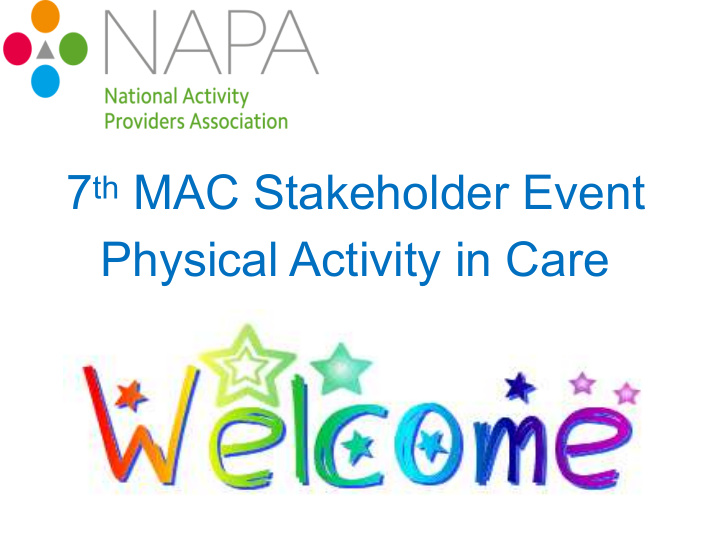



7 th MAC Stakeholder Event Physical Activity in Care
What ‘moving’ do the people you support do now? How might they move more?
List all the ways in which the people you support are physically active during a day
List all the reasons why physical activity is important in the lives of the people you support ………
Why? • No matter what our general state of health is in later life, we all hope to remain active • Many older people and those with health are more vulnerable to developing the habit of inactivity and this is a huge problem, as habits are notoriously difficult to break • Inactivity is a major threat to health, greater than the natural ageing processes • Many conditions are associated with a sedentary lifestyle, these include: obesity, diabetes, strokes, raised blood pressure, chronic heart disease and depression
• Physical activity is naturally part of our day-to-day life e.g. going upstairs or downstairs, walking the dog, dancing, gardening and housework, bathing, washing, eating etc • For an increasing number of the population even the most basic of activities are no longer practical or even physically possible and we need to find alternative ways to bring physical activity into their lives • To be successful this type of activity must be presented in a manner that ensures it does not become a chore and most importantly is practical and enjoyable
Why physical activity? • Being physically active plays an essential role in ensuring health and well-being and there is a large body of research investigating the benefits of exercise • Keeping physically active can prevent major illnesses, and more importantly maintain or possibly improve what mobility and flexibility we still have and this is even more applicable for the people we support
What are the barriers to physical activity in the lives of the people you support ……………………………… ..
Barriers to being more active There may be many barriers to not engaging in a physical activity such as: • Mobility issues/challenges • Cost/need of equipment required • Poor sight/vision • Lack of confidence • No will power?! • Cant stick with it • Don’t have anyone to do it with • Fear of injury • Negative perceptions • Cant afford it
However…. • However, there are ways to overcome most of these potential barriers and work physical activity into your client’s daily life • This could start by encouraging those you support to collect their tea/coffee from a different room, every little thing helps … .
By bringing regular physical activity into people’s daily routine there are a huge range of benefits including: Improved heart function – decreasing the effects of chronic disease including coronary • heart disease Reduced blood pressure – This not only has a beneficial effect on overall health but • may reduce the amount of medication required Improved blood circulation – reduces swollen ankles and the incidence of leg ulcers etc • Increased energy – an improved blood supply to muscles will produce and store more • energy Increased strength – by working the muscles they are strengthened, which helps • posture and can also help to ease incontinence Reduced fatigue – which directly reduces the rate of injuries resulting from falls • Treat Depression – and also reduce your risk of depression and dementia. • Reduce Diabetes – exercise can halve your risk of getting type 2 diabetes, help to • control diabetes and prevent long-term complications. • Sleep – can improve your sleep • Raise Self –Esteem – physical activity can change your mood short term
When planning a physical activity session, you must take account of the following: • It is vital to know the physical limitations of the people you support • It could be too much to attempt too many physical activities in opne go • Remember that ‘little and often’ is good • Make a point of knowing which the best time of day is for the people you support • Always remind the people you support - “if it hurts, don’t do it”!
Think of 5 people you support – • How could their access to physical activity be improved? • List 5 physical activities they coukdl engage in during a day 1. 2. 3. 4. 5.
What are the benefits of being active daily? • Helps maintain cognitive function; • Reduces cardiovascular risk; • Helps maintain daily living skills; • Improves mood and can improve self - esteem; • Reduces the risk of falls. Chief Medical Officer guidance Oct 2011
Preventing falls Older adults at risk of falls, such as people with weak legs, poor balance and some medical conditions, should do exercises to improve balance and co-ordination on at least two days a week. These could include yoga, tai chi, dancing, etc. Chief Medical Officer guidance Oct 2011
Using stress balls Strengthen grip Try to increase the number of repetitions Promote range of movement Roll the ball along the arm from fingers to shoulder and back again. Repeat with other arm. Invent your own gentle movements too. Improve the power of leg muscles Place the ball between the knees and squeeze
Next steps
HOW TO CONTACT US Unit 1, First Floor Fairview Industrial Estate Raans Road, Amersham, Bucks, HP6 6JY TEL: 0207 078 9375 FAX: 0207 735 9634 info@napa-activities.co.uk www.napa-activities.co.uk
Recommend
More recommend